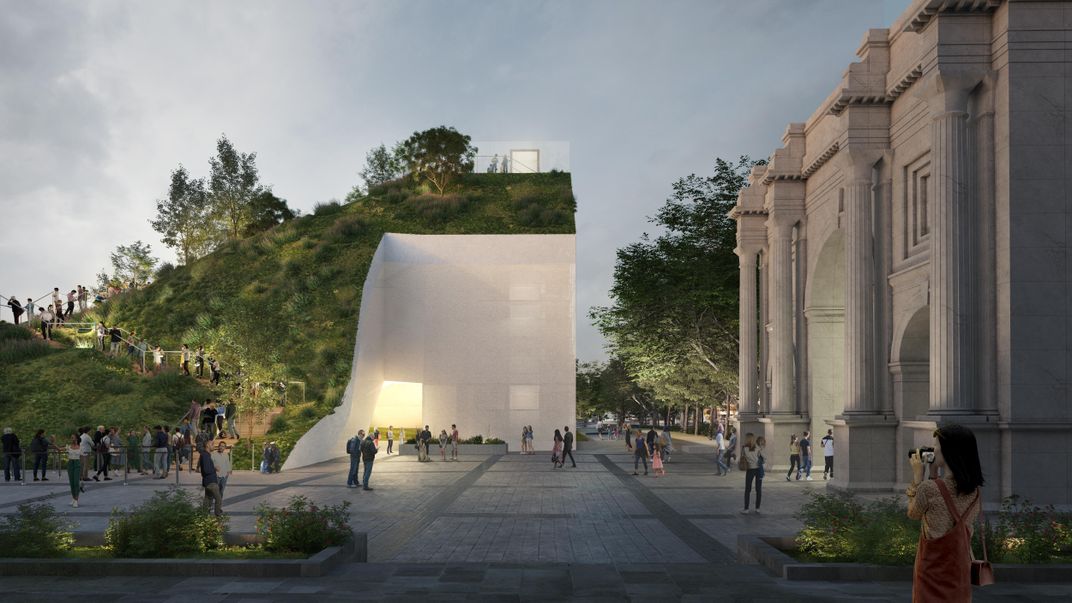Widely Mocked London Tourist Attraction Closes Two Days After Opening
The Marble Arch Mound sought to invigorate a major shopping district in England’s capital. Visitors called it a “bad Santa’s grotto”
:focal(3600x2018:3601x2019)/https://tf-cmsv2-smithsonianmag-media.s3.amazonaws.com/filer/56/55/5655e9f0-a51d-410e-bddf-538fd622c7ec/gettyimages-1331089499.jpg)
London officials had grand visions for the Marble Arch Mound, a temporary installation that opened this week next to one of the English city’s iconic landmarks.
Designs for the attraction depicted a lush, foliage-covered hill rising over the bustling shopping district of Oxford Street and greenery of Hyde Park. The mound’s purposes were numerous and lofty: to entice visitors back to the area as Covid-19 restrictions lifted, provide a new perspective of the neighboring Marble Arch and emphasize the importance of urban green space in the fight against climate change.
But those plans, it seems, have all gone downhill.
As Kate Plummer reports for the Independent, the Marble Arch Mound has closed after just two days following widespread complaints that the attraction failed to meet expectations. Instead of a soaring, verdant oasis in the middle of the city, visitors were greeted with sparse, earth-covered scaffolding. At 82 feet high, the mound is scarcely tall enough to offer a view over the trees into Hyde Park—though it does overlook a “fine display of commercial waste bins,” per the Art Newspaper.
Public criticism of the site was swift and rather merciless, with people comparing it to “awkward bits of land in ‘The Sims’” and a “bad Santa’s grotto.”
Marble arch mound is the worst thing I've ever done in London pic.twitter.com/njmpOFxrbf
— Emma Wright (@emmabethwright) July 27, 2021
“Marble arch mound is the worst thing I’ve ever done in London,” declared Twitter user Emma Wright, who posted a photo of herself looking glum in front of a wall of scaffolding.
Robby Walsh, who also trekked to the top of the mound, tells Alex Marshall and Isabella Kwai of the New York Times that the climb was “the worst ten minutes of my life.”
The mound cost £2 million (around $2.7 million) to build and was part of a larger initiative by the Westminster City Council to reinvigorate the Oxford Street District after more than a year of coronavirus-induced restrictions. Seventeen percent of shops in the area permanently closed their doors during the pandemic, according to the Guardian’s Lanre Bakare.
Officials enlisted acclaimed Dutch architecture firm MVRDV to design the installation. But the project ran into trouble in part due to dry and “challenging” weather, which made the sedum turf covering the mound appear brown and patchy, as an MVRDV spokesperson tells Greg Pitcher of the Architects’ Journal.
Speaking with the Times, representatives of the firm explain that it originally planned to build the hill over the Marble Arch but changed designs when concerns were raised about causing damage to the 19th-century landmark. The mound thus became smaller and steeper—which, in turn, made it more difficult to plant vegetation on its artificial slopes.

Other plans simply did not materialize: Per the Associated Press (AP), a shop, cafe and exhibition space planned to accompany the mound remained unfinished by the opening date.
The cost to climb the mound ranged from £4.50 to £8 for adults (around $6 to $11). In a July 26 statement, the City of Westminster said that it would offer a refund to anyone who booked a visit during the first week of the attraction’s opening—as well as a free return ticket so visitors can enjoy “the landscape once it has had time to bed in and grow.”
The city added, “We’ll continue to adapt and improve London’s newest outdoor attraction and resolve any teething problems as they emerge.”
The Marble Arch Mound is expected to stay in place until January 2022. MVRDV tells Tom Ravenscroft of Dezeen that its appearance will start to improve as dry conditions subside.
“Some elements were not ready, and it would have been better to wait until the greenery looked better,” the firm acknowledges. “But let’s give nature a chance.”